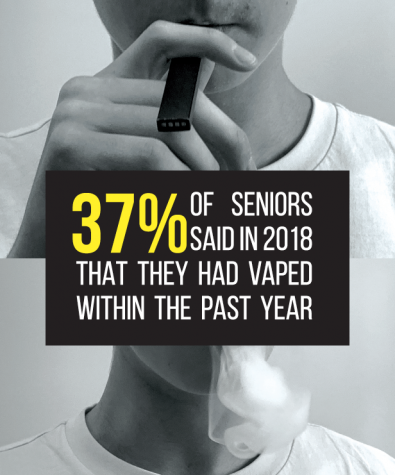Your donation will support the student journalists of Iowa City High School. For 2023, we are trying to update our video and photo studio, purchase new cameras and attend journalism conferences.
The Vaping Experiment: Are We the Guinea Pigs?
October 8, 2019
If the charger was gone, he couldn’t use his vape anymore. So Horace* flushed it down the toilet. This time he would actually quit. He had been vaping since sophomore year, and the psychological dependency he’d developed was beginning to frighten him.

According to the FDA 37% of seniors said that they had vaped within the past year.
“I was really trying to quit, but at the same time I didn’t want to actually quit and I regretted flushing it,” Horace said.
Determined to halt the tugging sensation of addiction, Horace searched the internet for another means of charging his vape. He found that it was possible to construct a makeshift charger by cutting a spare phone charging cord, but Horace didn’t have one available. He found an alternative.
“I found the charger to my electric toothbrush and cut it up,” Horace said. “When I attached it to the vape it exploded because the electric toothbrush charger was much bigger and thicker than an iPhone charger. But I was so desperate that I found a way to vape without having a vape. I had a pod and I found an iPhone charger. I connected the charger to the pod-like without the device itself: vaping without a vape. I was frying the juice and its pod for like a week, which was probably worse for me.”
According to the National Institutes of Health, in 2018, 37 percent of high school seniors reported vaping in the past twelve months, and the FDA found that the use of e-cigarettes among high school students increased 78 percent from 2017 to 2018. The CDC has seen over 500 cases of the unknown illness related to vaping as of September 2019, and devices that have been tampered with, similar to Horace’s, have been involved in many recent health concerns related to vaping. Within Iowa City, the University of Iowa hospitals have treated an alleged vaping-related illness.
“We actually had a patient in our intensive care unit a couple of weeks ago that had respiratory failure and required us to put a breathing tube in and support her with a mechanical ventilator,” Dr. Josalyn Cho, a specialist in lung disease who works in critical care at the University of Iowa, said. “We think that the cause for that respiratory illness was potentially related to vaping.”
Even though pulmonologists have been concerned about the popularity of e-cigarettes for many years, teenagers continue to use them more than ever before. A possible cause of these devices’ popularity may be advertisements from companies such as JUUL.
“I think a lot of doctors are really disturbed by the way that these products are advertised, particularly with the sort of introduction of some of these flavors,” Dr. Cho said. “It seems like [advertisements] target a different audience than the audience tha[n] e-cigarettes were really designed for. They were initially conceived as a way to help people stop smoking, but things have shifted in the past few years to introduce bubble-gum-flavored liquid and those sorts of things.”
Though vaping is what most teens do to access nicotine, some students don’t like the popularity associated with vaping and smoke cigarettes instead. Alex* doesn’t vape, but smokes cigarettes every once in a while.
“I didn’t want to be a normie and just give in to vaping,” Alex said. “With cigarettes, it seemed like there was more fun to it. For some reason, I like holding a cigarette in my hand, and the way that it feels. [Smoking] was more thrilling than vaping for me.”
As the respiratory illness associated with e-cigarette use has become more common and close to home, family and friends of e-cigarette users become more and more concerned.
“[My friends] are constantly hitting the vape,” Alex said. “Those are people that I really care about, and I want them in my life for a long time. It worries me that they’re doing something that’s really dangerous.”
Pulmonologists, doctors specializing in lung disease, are currently researching the dangers of this unknown vaping-associated respiratory syndrome. Dr. Cho suspects that this has been occurring for years, but doctors have only recently made headway in determining what exactly the respiratory disease is, including whether or not it’s a disease at all.
“Something is a disease if we know that there’s one cause, and something is a syndrome if there can be lots of different causes or patterns but it all kind of looks the same clinically,” Dr. Cho said. “Right now people are describing this as a syndrome. When we look in the lungs, we see different patterns of injury so it may not all be the same mechanism. There may be different things in different people contributing to respiratory failure.”
Beyond establishing what to call this phenomenon, pulmonologists are figuring out how to recognize it.
“There can be a whole range of symptoms,” Dr. Cho said. “While almost all patients [are] experiencing shortness of breath and cough, having a fever, other patients are coming in with things like nausea, vomiting, abdominal pain, diarrhea, and chest pain. If you’re vaping and you’re having any of those other symptoms, that’s another reason to think about stopping and to talk to your doctor.”
Though some symptoms of the syndrome are known, pulmonologists know little about what causes the need for immediate hospitalization. One main concern is the toxins in the e-liquids– what e-cigarette users use to refill their devices. E-cigarettes are not FDA approved as of September 2019. The FDA sent a warning letter to Juul and other companies giving them a period of 10 months to submit to re-approval; therefore, for the majority of 2019, companies that are selling e-cigarettes are doing so without approval from the FDA. A factor contributing to the need for this re-approval process is that some doctors have been theorizing that unknown compounds that are formed during the heating process of vaping may release harmful chemicals that contribute to the respiratory syndrome.
“We don’t even understand what it is that’s being inhaled,” Dr. Cho said. “It could be metals that are released from the devices that are used; it could be new chemicals that are formed from the heat in the reaction or mixing the chemicals together.”
Although the factors leading to the recent health incidents have been largely unknown, the CDC has identified several factors present in every death reported. One of these factors is the presence of Vitamin E. Vitamin E is a component normally found in skin ointments, but it has also been found in terpene thickeners in marijuana vaping cartridges, or carts. Terpenes and terpene thickeners are the main component in many marijuana vaping carts and are not harmful to the body when Vitamin E is absent from the cartridge. However, when combusted, Vitamin E has been linked to acute hypoxemic respiratory failure, or “wet lung,” the illness found in all vapers who have died.
Marijuana vaping products have become increasingly popular among teens and college students. According to the University of Michigan’s Monitoring the Future survey, the rate of college students who vaped marijuana doubled between 2017 and 2018.
“Last year, during the school year, a ton of people had carts. A lot of people who smoke [marijuana] have a cart,” Zivera* said.
Among the vast majority of deaths reported, THC, the psychoactive component of marijuana, has also been found. Consequently, students who have vaped both nicotine and marijuana cartridges have grown progressively more concerned about the health and psychological effects of their vaping on those close to them.
“I would feel bad for my parents have to go through me having done that to myself. And that would make me stop,” Gilbert said. “While you have it, you realize that it’s doing damage to you. You might even pay more attention to the negative side effects than to the pleasurable things about it. But then when you start to go a couple of days without it, you start to think only about the positives. It’s just like a breakup with someone.”
Even with widespread grave concern about the dangers of e-cigarette use, the inescapability of addiction has kept students from trying to quit.
“I could die,” Gilbert said. “This could kill me out of nowhere, and that’s kind of scary. Even if I stopped for a couple days, I could still just like die, so it’s scary. I feel like I don’t have enough willpower to stop immediately.”
According to Dr. Cho, the first step to quitting is asking for help. Numerous studies have shown that addicted individuals need to make the decision to quit themselves in order to triumph over addiction.
“To make for a successful attempt at quitting, patients need to decide that they’re ready and subsequently…pick a date and pick a strategy that they’re going to use,” Dr. Cho said.
Students agree with Dr. Cho, and believe that it is important for those addicted to realize they have a problem themselves before others intervene. In addition, many students believe it is not their responsibility to tell others to quit, and that the onus falls on vapers themselves to cease their habit.
“They made the choice to do it in the first place,” Alex said. “Especially if they’re addicted, I don’t feel like I had the authority [to tell them to quit]. I don’t want people to feel like I’m putting them down or telling them what to do.”
Gilbert, who has been addicted for a year, agrees that vapers should take responsibility for both starting and quitting.
“Once you have an addiction it becomes a very personal thing, especially when you’re trying to stop yourself from doing it,: Gilbert said. “Once other people start to try to influence you, you start to get angry with them. You feel like they’re trying to control you, because at that point it’s something that’s really close to you—it’s almost like a relationship with a person.”
In a University of Iowa survey of Iowa City high school seniors, 50 percent responded that they had vaped before. Because e-cigarettes are still very new to the market, research about the effects of vaping is just beginning. These devices have the potential for a variety of effects on the American population. E-cigarettes can deter the use of combustible cigarettes, but users of these devices are developing an unknown respiratory disease that has yet to be understood.
“Vaping is not harmless,” Dr. Cho said. “It’s not worth the risk. If you haven’t started, don’t, and if you are vaping it’s really important to make every effort to stop.”
*Names changed for anonymity.


JOHN FRANCIS MEEHAN II • Dec 8, 2020 at 12:36 am
I am 45 and regrettably I began smoking cigarettes in 1991 at age 16. I still smoke. My brother is 43 and started at the same time and is now going through Stage 3 esophageal cancer related to smoking. He is going through Chemotherapy and according to the ACS he statistically has a 25% chance of living 5 years. A surgury is planned for January 2021. I tried vaping. It irritates my brochial passages badly so – as stated; regrettably I still smoke. I am a nicotine addict. I would implore anyone to never try tobacco. It is addictive and carcinogenic- and deadly.